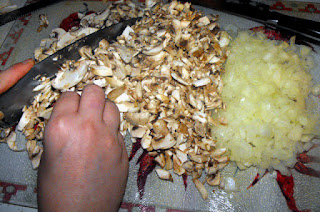This year it was time to try something a little different however, as we decided to use up a pork loin we had in the freezer and make a pork version of the traditional beef wellington. Here we've cut the pork loin in half down the middle and we'll only be using the right half, saving the left side for another dinner the next week.
We got some amazing Wild Tree seasonings as a gift that Christmas morn from my mom, and we used the rancher steak rub to coat the sides of the pork loin.
To start the wellington cooking process, first get a few tablespoons of oil piping hot in a pan at medium-high heat. When the pork loin goes in it should start sizzling like crazy.
Each side is cooked for a few brief minutes to ensure the outer edges are all golden brown before the actual baking in the oven begins.
Don't forget about the end pieces though! Here Megan is holding the loin in place with tongs to ensure the top and bottom sides also get browned.
After the browning here's our perfect loin waiting to be coated in veggies and wrapped up in dough.
Normally a wellington would be coated in liver pate, but we wanted to go a vegetable route instead and decided on mushrooms and onions.
After being chopped up, the onions and mushrooms are cooked in the same skillet that is still coated in a glaze of delicious pork flavor.
While the vegetables soften, Megan lays out two sheets of puff pastry. Rather than making our own we just went with store bought, and you can find these in the frozen section of the grocery store, usually near the whipped cream or frozen fruit.
The cooked vegetables are laid down as a bed for the bottom side of the loin on the puff pastry, then also spread by hand on top so it sticks better.
Both the top and bottom should be well coated with the onions and mushrooms.
The dough is then wrapped up on all sides to completely cover the meat and filling.
The dough is scored with a knife and then brushed with melted butter.
After about half the baking time here's how the dough starts to take on the golden brown hue. We don't want it to go too far and become black however, so for the second half we'll cover the pan in tin foil.
And here's the perfectly flaky and golden baked dough after the wellington comes out of the oven.
The wellington is sliced into a series of pieces about an inch thick.
Here's each slice, and you can see one of them lost its dough covering, revealing how the coating/filling looks as well.
A plate of our prepared Christmas dinner features two pieces of wellington, mashed potatoes and gravy, green bean casserole, and a crescent roll.
This will be our last post of 2012 - see you next year for more ways to make fantastic pork dinners, new and innovative takes on pasta classics, and a storm of European world tour entries! Happy New Year!






















































